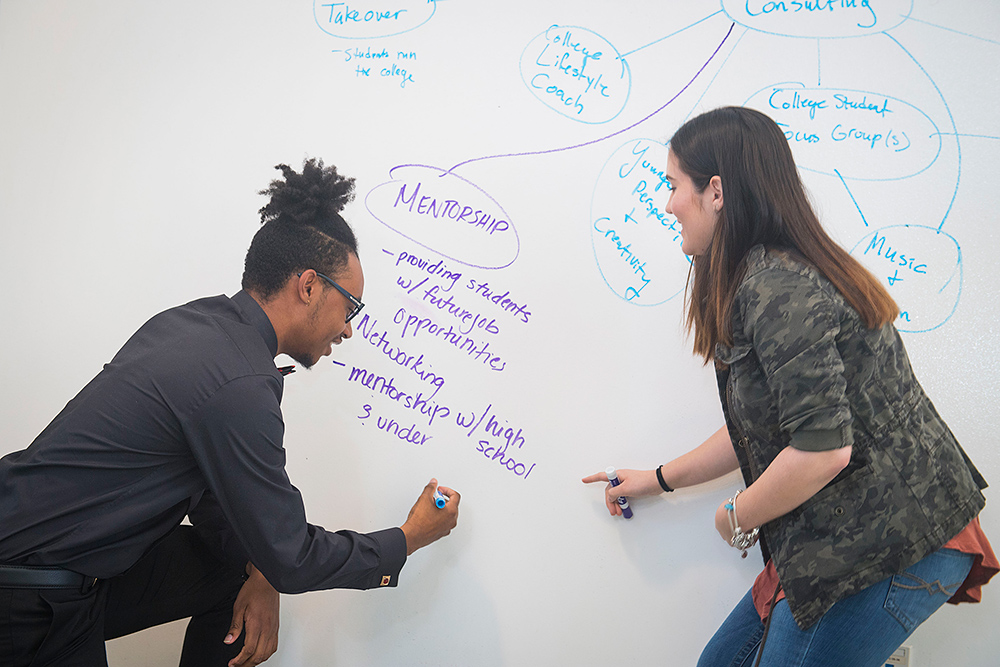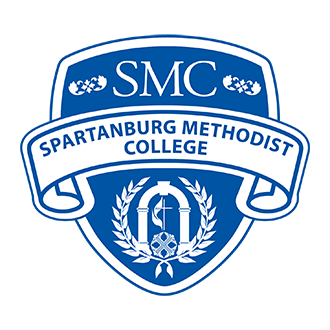Professional Development is at the Core of an SMC Degree
By Jeremy Handel
 Dr. David English Camak had a vision when he founded the Textile Industrial Institute in 1911. It was a partnership between industry and community that would provide workers with the education and training they needed to advance their careers. It also provided the local textile industry with better educated and prepared workers.
Dr. David English Camak had a vision when he founded the Textile Industrial Institute in 1911. It was a partnership between industry and community that would provide workers with the education and training they needed to advance their careers. It also provided the local textile industry with better educated and prepared workers.
The Institute has undergone a few changes over the years on its way to becoming Spartanburg Methodist College, but the vision of Dr. Camak to give students the tools for a better future remains. The College’s professional development program and Camak Core courses were designed to enhance students’ core coursework with the soft skills that hiring managers say are lacking in college graduates.
“In survey after survey, companies say college graduates need to have stronger skill sets like problem solving, communication, and leadership,” said SMC President Scott Cochran. “We’ve built our professional development program around those key skills that help our graduates stand out among other candidates.”
SMC has taken career preparation one step further than most other higher education institutions by making professional development a required part of the curriculum for its bachelor’s degrees.
“We want students to leave SMC confident in the academic knowledge they gained in their chosen areas of study and just as confident in their ability to tackle problems organizations are facing, lead a group project, and communicate like a seasoned professional,” said Courtney Shelton, vice president for student and professional development at SMC. “Whether they go into a job directly related to their field of study or decide to go another direction, these skills will benefit them on any path they choose.”
Professional Development for First Year and Sophomore Students
Professional development at SMC starts right away, with some coursework and academic advising in the first year that focuses on career skills. SMC 101 is a course that helps students acclimate to college life. It also provides a baseline for professional development.
During SMC 101, students learn time management, good study habits, how to register for classes, and other college life skills. What SMC adds to this typical orientation course is opportunities to enhance future career skills, like success tips, career panels, and a PathwayU career assessment.
The idea is to build students’ mindsets early to focus on more than just getting a job out of college but also succeeding at that job right from the start. With the PathwayU assessment, students can get an idea of what potential career paths would interest them based on what their life interests are.
“Many students aren’t sure what they want to do when they first come to college. We inform them about various career options and show them a possible path,” said Megan Georgion, dean of career and student success. “Then we provide experiences to explore those options further and connect with professionals in the field, which gives students the confidence to continue down that path.”
In their sophomore year, students expand on the career and success focused lessons. SMC 201 picks up the professional development mantle, focusing on more specific skills like resume and cover letter writing, career exploration through career fairs and panels, and setting up and managing a professional LinkedIn account. Students also learn some basic networking and professional communication skills.
While many may see these skills and tasks as basic knowledge, many students have never been exposed to them. Most are learning for the first time what a resume is and why it’s important to have one.
“What really makes SMC different is that we expose all students to these skills and experiences as part of their degrees,” Shelton says. “At most, if not all, other liberal arts colleges, students have to go to a career center to gain these skills and experiences. That takes extra time that a lot of students just don’t have because they’re also working part-time or even full-time jobs while trying to fit in college.”
By giving students these hands-on experiences early in their college careers, SMC provides basic professional tools to students who decide to pursue a career after their associate degree. It also provides a baseline to our bachelor’s degree students who will then learn more skills for success.
The Camak Core for Juniors and Seniors
As students move into their junior and senior years, they focus on classes in their chosen degree program. The professional development program also gets more specific and skills oriented. Students’ final two years include six professional development courses called the Camak Core.
Camak Core Courses
• Community Discovery and Engagement
• Professional Development and Leadership
• Professional Communications
• Applied Technology
• Semester Internship
• Capstone
An homage to the career preparation mission of the College’s founder, the Camak Core teaches the skill sets employers say they want in graduates but not enough of them have when they graduate. The courses are also flexible to allow them to evolve as techniques and technology change and new, desired skill sets are identified.
The National Association of Colleges and Employers (NACE) surveys employers every year on the skills they are looking for in college graduates. With some minor changes from year to year, the list typically includes skills such as problem solving, teamwork, communication, and analytical skills at the top. It provides a general roadmap for the Camak Core curriculum.
“The NACE survey is a natural resource for us to use to guide the skills-based instruction of the Camak Core program,” said Victoria Novak, director of online professional development and certifications. “If we want to make our students workplace ready, then we need to give them the skills the workplace is looking for.”
Learning Communication and Leadership Skills
In their junior year, students focus on learning the skills needed to succeed, including professional communication, common technology and software used in the workplace, working in a group setting, and more.
Communication will be critical in any workplace our graduates join. Understanding how to communicate both professionally and effectively is a cornerstone to success in most areas of the working world. Students learn how to communicate professionally and why it’s important. From emails and reports to interpersonal communications and networking, they study and practice techniques to succeed.
The Camak Core also focuses on preparing students for getting a job, with more in-depth resume writing and interview skills. Students complete a full mock interview scenario – from researching the company to sending a thank you note and even salary negotiation.
Learning the common technology and software programs used in the workplace also gives SMC students an advantage. Learning basic skills in spreadsheets, presentation programs, social media, and web page creation provide a wide base of knowledge that can be used in almost any workplace.
Leadership is not necessarily something you can learn in a class. It’s often something you have to learn over time and on the job, but understanding leadership styles and skills can put students on the right path to developing into effective leaders. Finding a mentor who can be a trusted guide and sounding board helps workers develop into leaders, and students work to establish such a relationship in the Camak Core.
“We want to give our graduates every advantage possible to put them on a path to success,” said Clara Jane Hallar, director of marketing for the SMC Experience and a professional development faculty member. “Helping them find a mentor to guide them through their career also helps them start a strong network of professional contacts.”
Studying different styles of leadership and discovering which style best suits the student helps guide their experience. They also study skills that leaders will be responsible for, including finance and budgeting, giving and receiving constructive feedback, and conflict management.
After learning the skills that will help them succeed, the final year for most professional development students focuses on employing those new skills.
Putting the Skills to Work: Consulting Project, Internship, and Capstone
With the theory and understanding of the skills needed to succeed in the workplace, students then put what they’ve learned into action.
Community discovery and engagement gives students not only knowledge of how to work in groups to address problems, but it also gives them their first chance to take a hands-on approach in applying the skills they have learned. Students are engaged with a local company or organization in a consulting role to address an issue the organization is having. As a group, the students research the issue, develop a solution or several options for a solution, and present their findings back to the client.
“Love it or hate it, group work is a part of most organizations,” Shelton said. “The consulting project allows students to discover their strengths and weaknesses in a safe place – before they’re on the job where failure has real consequences. They learn just how important every part of the team is in accomplishing a goal.”
Students are also required to complete an internship over the course of their final two years to gain career relevant work experience for their resumes, Shelton added. While many students have work experience, the internship program allows students to develop career relevant experiences that better position them to be competitive in the job market.
The culmination of the Camak Core comes in their senior year with the Capstone project. This final course has students establishing their own business, event, philanthropic effort, or other venture that will put all of their skills to the test. It starts with a networking event in which the students present their idea to a group of attendees and seek feedback to better focus their project.
“The Capstone is an intensive project that allows students to show their entrepreneurial spirit and tests the skills they have learned,” Shelton said. “It combines time management, problem solving, networking, promotion, and more.”
As students establish and operate their project, they study the results to prepare for their final report. To close the semester, each student must build a presentation about their project, its success, and how they could improve it.
The students are then tasked with making their presentation to a panel of judges made up of faculty, staff, or local business or philanthropic representatives. The panel provides feedback to the student and their instructors, which can weigh into their grade. This comprehensive project is a great experience for students to test their abilities and put their education to work.
Building Workplace-Ready Graduates
With SMC’s history as a work-study school in its early days, building professional development directly into the degree programs just fits. Graduates leave SMC with the tools and knowledge to succeed in their first job and every other job they’ll have throughout their working lives.
Professional Development. How Can You Help?
Developing workplace-ready students takes more than lessons in the classroom; we look to community partners to help us provide our students the knowledge and experiences they need.
As a friend of SMC, you can help us in our quest to provide students with those experiences. If you, or someone in your network, has opportunities available for our students, please let us know.
Opportunities to help SMC professional development students include:
- Providing internships
- Serving as a guest speaker/lecturer
- Partnering for a student consulting project
- Serving as a Capstone key partner
- Participating in SMC recruiting/job fairs
- Participating in mock interviews
- Posting open jobs on our Handshake portal
- And even hiring our students.
For more information on how you can partner with SMC, visit www.smcsc.edu/hireexperience or contact Emily Lausier at lausiere@smcsc.edu or 864-278-5823. See how you can help
